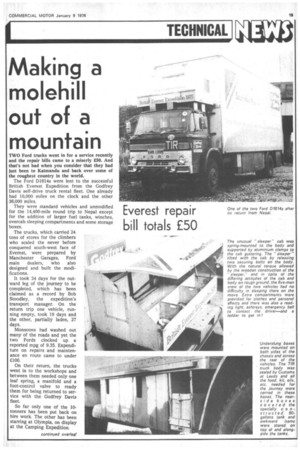Making a molehill out of a mountain
Page 21

If you've noticed an error in this article please click here to report it so we can fix it.
TWO Ford trucks went in for a service recently and the repair bills came to a miserly £50. And that's not bad when you consider that they had just been to Katmandu and back over some of the roughest country in the world.
The Ford D1614s were lent to the successful British Everest Expedition from the Godfrey Davis self-drive truck rental fleet. One already had 10,000 miles on the clock and the other 36,000 miles.
They were standard vehicles and unmodified for the 14,400-mile round trip to Nepal except for the addition of larger fuel tanks, winches, overcab sleeping compartments and some storage boxes.
The trucks, which carried 24 tons of stores for the climbers who scaled the never before conquered south-west face of Everest, were prepared by Manchester Garages, Ford main dealers, who also designed and built the modifications.
It took 24 days for the outward leg of the journey to be completed, which has been claimed as a record by Bob Stoodley, the expedition's transport manager. On the return trip one vehicle, running empty, took 19 days and the other, partially laden, 27 days.
Monsoons had washed out many of the roads and yet the two Fords clocked up a reported mpg of 9.35. Expenditure on repairs and maintenance en route came to under E100.
On their return, the trucks went in to the workshops and between them needed only one leaf spring, a manifold and a foot-control valve to ready them for being returned to service with the Godfrey Davis fleet.
So far only one of the 10tonners has been put back on hire work. The other has been starring at Olympia, on display at the Camping Expedition.
The unusual " sleeper" cab was spring-mounted to the body and supported by aluminium clamps to the cab guttering. The "sleeper'' tilted with the cab by releasing two securing bolts on the body. With the natural torque allowed by the wooden construction of the sleeper," and in spite of the differing attitudes of the cab and body on rough ground, the five-man crew of the two vehicles had no difficulty in sleeping there on the move. Extra compartments were provided for clothes and personal effects arid there was also a reading light, ashtrays, emergency bell to contact the driver—and a ladder to get in
Underslung boxes were mounted on both sides of the chassis and across the rear of the vehicles. The T1R truck body was sealed by Customs at Leeds and all the food, kit, oils, etc, needed for the journey were carried in these boxes. The nearside boxes covered the specially c o n structed 80gallons tank and awkward items were stored on top of and alongside the tanks,




















































































